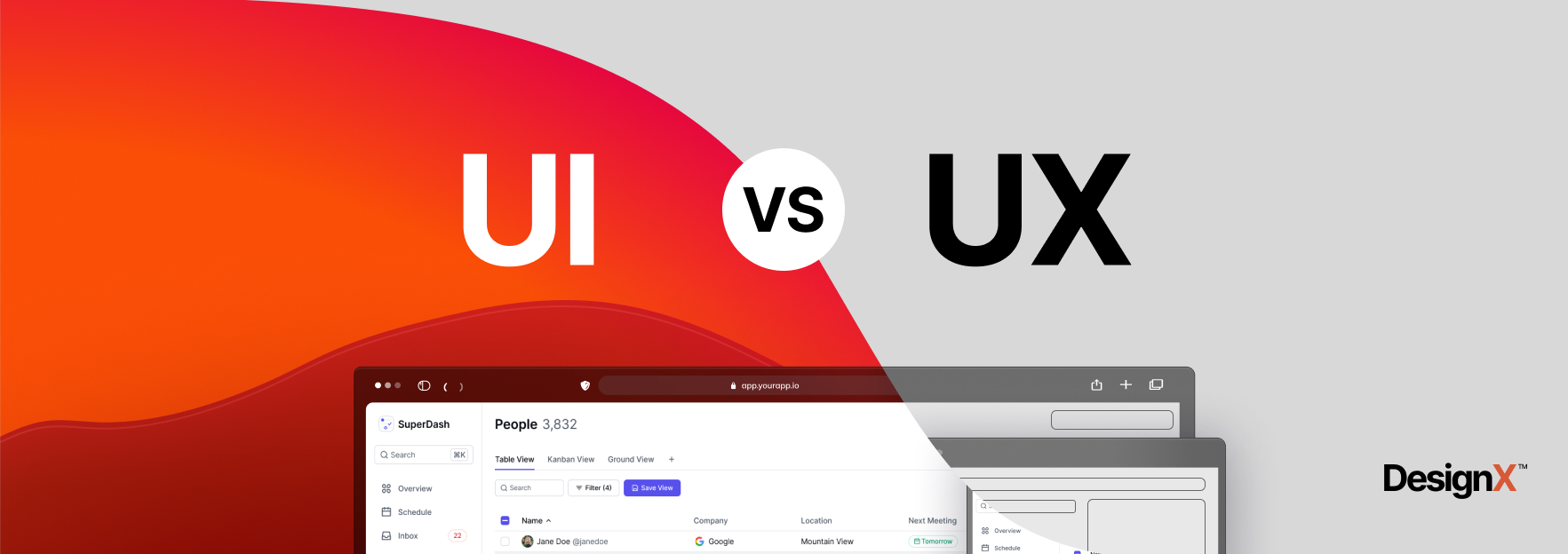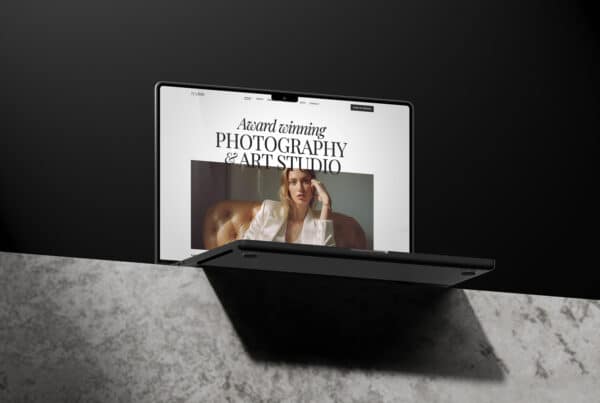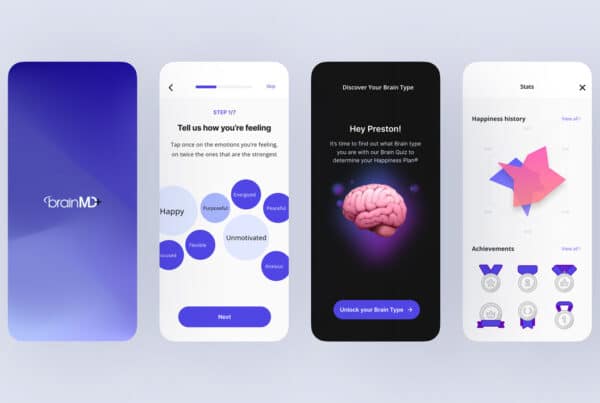Introduction
In the world of UX design, finding the right balance between user experience design and functionality is a constant challenge. A UX designer must ensure that both the visual design and usability of a product are harmoniously integrated. At DesignX, in all of our design projects, we have mastered this art by understanding that design is the process of making informed decisions that cater to user needs while maintaining an attractive interface. This delicate balance is what makes the experience of interacting with a product both enjoyable and effective.
The Role of Aesthetics in UX Design and Interaction Design
Visual Appeal and First Impressions
First impressions are crucial in the differences between UX and UI design. A visually appealing UI can immediately capture a user’s attention and encourage them to explore further. At DesignX, our design team has consistently delivered stunning visuals that draw users in, making them more likely to engage with the product. For example, our work on the Bodybuilding.com app involved creating a design portfolio that showcased both aesthetic brilliance and functional efficiency.
Emotional Impact
A well-designed aesthetic can evoke positive emotions, creating a pleasant user experience. Colors, fonts, and imagery all play a role in how users feel when interacting with a product. Our project for TapMango, a comprehensive customer loyalty platform, leveraged vibrant colors and engaging visuals, resulting in a 25% increase in user retention. This shows how UX design focuses on creating an emotional connection with the user, enhancing the overall user experience.
Brand Identity and Recognition
Aesthetics are crucial for establishing brand identity. Consistent use of colors, logos, and design elements helps in building brand recognition and trust among users. At DesignX, we ensured that our work with Hewlett Packard was not only functional but also visually consistent, contributing to a 15% increase in brand recall. This approach underscores the importance of aesthetics in reinforcing brand values and identity.
The Role of Functionality in User Experience Design
Usability and User Experience
Functionality ensures that the interface design is usable, allowing users to navigate, find what they need, and complete tasks efficiently without frustration. Our user testing and UX research services at DesignX have been pivotal in refining interfaces for our clients. This is where we conduct research via target customer identification, surveys, partnering with business stakeholders and more to really dig into the details. This allows us to understand what visual design, interaction design, user flows and more really resonate with the key user personas. This method is grounded in Design Thinking, focusing on generating value for the user and tackling genuine issues as the top priority. For instance, our redesign of TapMango’s interface led to a 40% improvement in UI intuitiveness. This highlights how a user-centered design approach prioritizes usability to enhance the overall customer satisfaction.
Efficiency and Effectiveness
A functional UX design is efficient and effective, enabling users to achieve their goals with minimal effort and time. It’s about making the user journey as smooth as possible. In our work with AI startups, we focused on streamlining the user experience to improve overall efficiency and effectiveness, resulting in a 30% increase in user engagement. This demonstrates the importance of functionality in ensuring that the design meets user expectations effectively.
Accessibility and Inclusivity
Functionality also encompasses accessibility for optimal user experience design. A well-designed UX should be inclusive, catering to users with diverse needs, including those with disabilities. At DesignX, we prioritize accessibility in all our projects, ensuring that our designs are usable by all, including those with special needs. This approach ensures that the entire user journey is smooth and accessible to everyone.
The Interplay Between Aesthetics and Functionality throughout the user flow
Balancing Visual Appeal with Usability
The challenge lies in balancing visual appeal with usability. A design that looks good but is hard to use will frustrate users, while a highly functional design that’s unattractive may not engage users. In traditional graphic design, the focus is typically on typography, visual appeal, branding, messaging and standing out in the context of where the design will live. Throughout the UX design process, it’s important to also consider the context of usability. After all, people don’t necessarily interact with your logo, but they do interact with your website and other digital products. Having top talent with these specific UX design skills is paramount in striking the right balance between visual appeal and usability. The talent here at DesignX has 20+ years of experience in this very thing. Concrete examples of our skills can be seen in the successful redesign of Bodybuilding.com’s entire website, which showcases our ability to find a perfect balance between increasing user engagement and satisfaction. This demonstrates how UX designers use a range of strategies to integrate both aesthetics and functionality.
Case Studies of Successful Integrations
Several successful designs manage to strike this balance. For instance, our work with Black Box VR, the world’s first VR gym, combined stunning visuals with exceptional functionality, resulting in high user engagement rates compared to traditional VR applications. This showcases how good user experience design can be achieved by balancing aesthetics and functionality.
Common Pitfalls in UX Design
Common pitfalls include overloading the design with too many elements, which can overwhelm users, or focusing too much on aesthetics at the expense of usability. At DesignX, we avoid these by adhering to a user-centered design approach and iterative testing. This approach helps UX designers work efficiently, ensuring that both visual appeal and functionality are balanced.
Aesthetics-First Approach
Advantages
An aesthetics-first approach can create a strong emotional connection and a memorable user experience. It can also differentiate a product in a crowded market. For example, our design for HapiBrain, a mental wellness app, leveraged aesthetics to create a soothing and engaging experience, significantly improving user satisfaction. This approach highlights the role of aesthetics in enhancing the overall experience.
Disadvantages
However, focusing too much on aesthetics can lead to neglecting functionality, resulting in a beautiful but impractical design. At DesignX, we ensure this doesn’t happen by integrating functionality checks at every design stage. This balance ensures that the design encompasses both visual appeal and usability.
Examples
Websites like Dribbble showcase designs that are visually stunning but sometimes lack practical usability. We use such examples as learning points to strike a better balance in our projects. This approach helps us create design solutions that are both beautiful and functional.
Functionality-First Approach
Advantages
A functionality-first approach ensures that the design is usable and meets users’ needs effectively. It’s practical and user-focused. For instance, our redesign of the TapMango platform focused heavily on usability, leading to a 50% increase in development speed and a 25% increase in client retention rates. This highlights the importance of functionality in all design disciplines.
Disadvantages
However, it can sometimes result in a design that feels too utilitarian and lacks emotional appeal. At DesignX, we mitigate this by incorporating visually appealing elements without compromising on functionality. This balance ensures that the design focuses on both user goals and visual appeal.
Examples
Early versions of Craigslist focused heavily on functionality, sacrificing aesthetics, yet they were highly effective. We draw inspiration from such examples to ensure our designs are both functional and visually appealing. This approach helps us create designs that enhance the overall user experience.
Strategies for Balancing Aesthetics and Functionality
User-Centered Design
User-centered design involves understanding users’ needs and preferences through research and designing with them in mind. At DesignX, we prioritize this approach, ensuring our designs resonate with the target audience. This user-centered approach is at the core of our UX designer’s role.
Iterative Testing and Feedback
Regular testing and feedback help in refining both aesthetics and functionality, ensuring a balanced design. Our usability testing services at DesignX have been instrumental in refining designs based on user feedback. This approach helps us create designs that enhance the entire user journey.
Collaboration Between Designers and Developers
Close collaboration between designers and developers ensures that both aesthetics and functionality are given equal importance. At DesignX, we foster a collaborative environment that encourages this synergy. This approach helps UX designers use their skills effectively to create balanced designs. To become a UX Designer at the top of your craft, this collaboration and communication aspect cross-department is paramount.
The Impact of Technology on UX Design
Advances in Design Tools
Modern design tools offer advanced features that help in creating both beautiful and functional designs. At DesignX, we leverage tools like Figma and Adobe XD to streamline our design process. These tools are essential for UX and UI designers to create effective designs.
Role of AI and Machine Learning
AI and machine learning can personalize user experiences and predict user needs, enhancing both aesthetics and functionality. Our AI design services at DesignX integrate these technologies to create smarter and more intuitive designs. This approach highlights the importance of technology in the product development process.
Future Trends
Future trends include more immersive experiences with VR and AR, which will require a careful balance of aesthetics and functionality. At DesignX, we stay ahead of these trends to deliver cutting-edge design solutions. This approach helps us create designs that are future-ready and user-focused.
The Business Perspective
ROI of Good UX Design
Investing in good UX design can significantly impact the ROI by improving user satisfaction and loyalty. Our work at DesignX has consistently delivered high returns for our clients by focusing on both aesthetics and functionality. This approach highlights the importance of UX design in the design industry.
Market Competitiveness
A well-balanced UX design can differentiate a product, making it more competitive in the market. Our design strategies at DesignX have helped clients like Nike and eBay stand out in their respective markets. This approach helps us create designs that are both competitive and user-focused.
Case Studies of Business Success
Companies like Airbnb and Spotify have achieved success through a balanced approach to UX design. At DesignX, we draw inspiration from such success stories to inform our own design practices. This approach helps us create designs that enhance the overall experience for users.
How UX Designers Measure Success
Key Performance Indicators (KPIs)
KPIs such as user engagement, retention rates, and conversion rates help in measuring the success of UX design. At DesignX, we track these metrics to ensure our designs are delivering the desired outcomes. This approach helps us create designs that are both effective and user-focused.
User Feedback and Surveys
Regular user feedback and surveys provide insights into how well the design meets users’ needs. Our research services at DesignX are designed to gather and analyze this feedback effectively. This approach helps us create designs that are informed by user needs.
Analytics and Data-Driven Decisions
Data analytics help in making informed decisions to improve both aesthetics and functionality. At DesignX, we leverage data to continuously refine our designs. This approach helps us create designs that enhance the overall user experience.
Common Misconceptions About UX Design
Aesthetics vs. Functionality Myth
The biggest misconception is that aesthetics and functionality are mutually exclusive. In reality, they complement each other. At DesignX, we ensure both aspects are integrated seamlessly. This approach helps us create designs that enhance the overall experience for users.
Cost and Time Misconceptions
Another misconception is that good UX design is costly and time-consuming. With the right approach, it can be efficient and cost-effective. Our efficient design processes at DesignX prove this. This approach helps us create designs that are both cost-effective and user-focused.
The Role of User Research
User research is often underestimated. It’s crucial for understanding user needs and creating a balanced design. At DesignX, we prioritize user research to inform our design decisions. This approach helps us create designs that are informed by user needs.
Conclusion
In conclusion, achieving a balance between aesthetics and functionality in UX design is essential for creating a successful product. Both aspects are equally important and should complement each other. By focusing on user-centered design, iterative testing, and close collaboration, designers can create products that are both beautiful and highly functional. This approach helps us create designs that enhance the overall experience for users.
Frequently Asked Questions about Aesthetics and Functionality in UX Design
1. What is the importance of aesthetics and functionality in UX design?
UX design focuses on creating user experiences that are both visually appealing and functional. The UX designer combines visual design elements with interaction design to enhance the overall user experience.
2. How do aesthetics and functionality impact user engagement?
User interface elements that are aesthetically pleasing and functional contribute to a positive user flow, leading to increased user engagement. UI designers strive to balance beauty with usability to keep users engaged.
3. What role does user research play in achieving a balance between aesthetics and functionality?
User research helps UX designers understand user preferences and behavior, enabling them to create interfaces that are both visually appealing and functional. It guides decisions in the design process to meet user needs effectively.
4. How can UX designers optimize aesthetics and functionality in their designs?
UX designers can optimize aesthetics and functionality by conducting user testing and gathering user feedback. Iterative testing helps refine designs to ensure they meet both aesthetic and functional requirements.
5. What are the key skills required to excel in balancing aesthetics and functionality in UX design?
Proficiency in visual design, interaction design, and an understanding of user-centered design principles are essential for UX designers aiming to balance aesthetics and functionality in their designs.
6. How does UX and UI design influence the overall user experience?
They work together to create a seamless and engaging user experience. While digital interface design (UI) focuses on the look and feel of the interface, UX design ensures that it is intuitive and functional.
7. What are the differences between UX and UI design when it comes to aesthetics and functionality?
UX design involves the overall user journey and functionality, while UI design focuses on the visual aspects of the user interface. Both are crucial for creating a balanced and effective user experience.
8. How can I improve the usability of my design?
Focus on user research, simplify navigation, and conduct regular usability testing to identify and fix issues. These steps help ensure that the design is both functional and user-friendly.
9. What are some tools for balancing aesthetics and functionality in UX design?
Tools like Sketch, Figma, and Adobe XD help in creating visually appealing and functional designs. These tools are essential for UX and UI designers to craft effective user interfaces.
10. What are the future trends in UX design regarding aesthetics and functionality?
Future trends include immersive experiences with VR and AR, personalized user experiences through AI, and more inclusive designs. These advancements will further enhance the balance between aesthetics and functionality in UX design.



